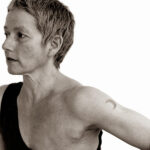That Time White Supremacy Meant That I Didn’t Get Shot
September 9, 2016
When Yogis Stiffen Up And Find the In-Between
September 28, 2016_____
When I present on the tangled history of early modern postural yoga, I detail what we know about the teaching modes at the Mysore Palace, the privations suffered by the young Iyengar, and Jois’ accounts of beatings. I ask participants to consider whether it’s possible that this colonial-era cruelty and spiritualization of pain has vibrated through yoga pedagogy ever since, given the stories of intrusion and injury and abuse coming to light, which are made less visible under the stories of healing and awakening.
I ask them to consider whether the basic premises of bodily goodness, personal agency and consent in adjustments that the broader yoga culture claims to value might in some ways be occluded by these historical echoes, especially as they blend with any unresolved sadomasochism in the personal psychologies of those who practice. I talk about becoming aware of assumptions towards bodies, and the power of projection upon and transference onto teachers, especially if they are charismatic, and especially if their physical instructions are grounded in metaphysical imperatives or anxieties.
This can all feel sticky in a room full of yoga teachers. Sometimes a participant will approach me with a troubled look while I’m packing up my gear. We’ll have an exchange that I’ve had enough times that I can offer a composite here:
_____
Participant: “That was a lot to take in. I teach (lineage x), and now I’m having doubts about whether or not I should.”
Me: (Oh shit.) “Um. Well, do you think the basic sensations and benefits you derive from practice will change just because you have more history on board?”
Participant: “Well, I’ll still have my practice, and its gifts.”
Me: “Totally.”
Participant: “I’ll still doing what I’m doing in the present. I know how it feels in my body. But what about for other people?”
Me: “Yeah. Yoga teachers are often taught to make subtle assumptions about what things feel like in other bodies.”
Participant: “How do we get around that? I want to be transparent about it.”
Me: “That’s hard. Have open discussions about experience with students? It really depends on class and student culture, and that’s sometimes out of your control. A lot of folks in (lineage x) do really well at fostering it.”
[Pause.]
“It also helped me to examine my expectations for my students’ bodies. Like whether I felt gratified if they reported experiences that resonated with me, but bummed if they didn’t. That made the whole thing clearer for me.”
Participant: “Okay, but what am I supposed to do with all that?” (Points at my laptop, where all the jagged slides live.)
Me: “Um…” (fumbles with shirt).
Participant: “Well how do you deal with it?”
Me: “Lots of chocolate” (laughs).
“I mean, I’d been told that yoga is simply a good and holy thing that came from a good and holy place. I saw how that story can cover over the strange motivations and hidden wounds that I practiced with and maybe others did too. So it became an important point of inquiry in my practice, and made me wonder about the diversity of people’s experience.”
Participant: “So what about the adjustments? Do you think we should do them?”
(In the talk I described how modern yoga adjustments have changed enormously over the decades, but had originally emerged from a culture of corporal punishment. Many who hear this for the first time are shocked and wonder for a moment whether they’ve been abusing students by simply touching them. In the vast majority of cases this of course isn’t true. But considering the history, our capacity to rationalize invading the space of others, and waking up to the diversity of responses to touch must ultimately be a good thing.)
Me: “I don’t do (lineage x) so I don’t know.”
Participant: “Well what about adjustments in general?”
Me: “I imagine that the primary consideration is how the adjustments foster relationship between teacher and student, and that’s a totally personal thing. Some people say it’s the most important thing of all. It reaches deep into our history of needs.
“I do know that people who study the neurology of movement say that putting somebody into a position that they can’t get into or out of by themselves is a really bad way of teaching them how to get to that position. So on that level it would seem that adjustments — especially those that take a person deeper into a pose — would nurture dependency on the teacher.”
Participant: “But it’s so ingrained, and the students seem to expect it.”
Me: “And there’s a problem with implied versus explicit consent in some rooms, and whether some students who come into those rooms have diminished capacities for consent. Some teachers scoff at that problem, but the people who spend their lives studying and recovering from trauma don’t.”
“And lots of people are still getting injured from adjustments. So there’s that.”
“So there are some potential negatives. Then again, can that dependency and intimacy of touch be healing for some people if they experience it in an environment of trust? Absolutely. Can it transmit love and care? Absolutely.”
Participant: “So it really depends.”
Me: “I think it always did. I don’t think it wasn’t ever just good or just bad. Maybe going forward, we just turn habits into choices. Our choices to adjust and how, or not, will be more informed. In my opinion, trying to understand the complexity of our choices in regard to ourselves and others is a huge part of self-inquiry, aka yoga.
Participant: “So the ball’s in my court.”
Me: “Yeah.”
[Pause. A little anxious.]
Participant: “Um. Cool.”
_____
It’s at this point that again, I want to eat chocolate.